Brad Pitt has delivered unforgettable performances across decades in Hollywood. Here are his 30 best movies ranked from worst to best.
Brad Pitt has built one of Hollywood’s most impressive careers through smart project choices and fearless performances. From underdog baseball managers to haunted cowboys, these 30 movies showcase the incredible range that has made him a true Hollywood icon. Ranked from worst to best, these films highlight the depth and versatility of one of cinema’s most dependable leading men.
30. Cool World (1992)
Director: Ralph Bakshi
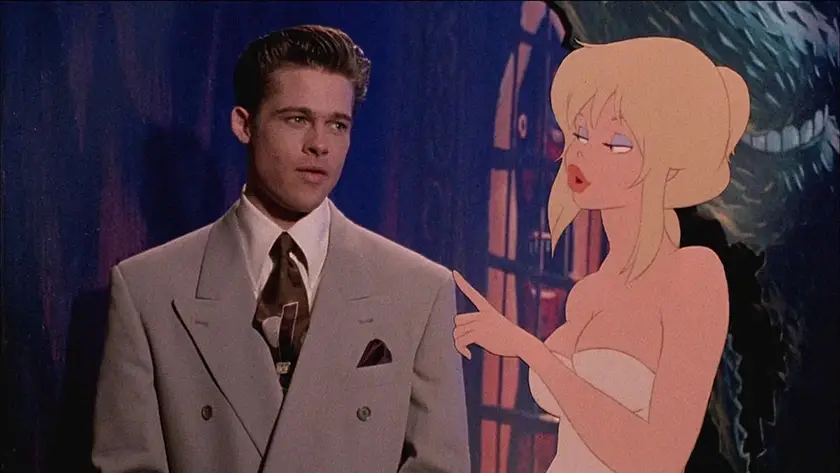
Ralph Bakshi’s live-action/animated hybrid disaster proves even Pitt’s conviction can’t save a doomed project. Playing a WWII veteran trapped in a cartoon universe (an oversexed riff on 1988’s Who Framed Roger Rabbit?), Pitt admirably commits to stopping Kim Basinger’s scantily-clad toon from romping with Gabriel Byrne’s human character and crossing into the real world. Made for $28 million but earning only half that, this ambitious misfire lacks the coherent storytelling needed to make its wild premise work. The script is nonsense, the tone is off, and the visuals are more headache than eye candy. Not even accidentally enjoyable, it hasn’t even managed to gain a cult following over the years, only representing Hollywood’s tendency to throw money at concepts without ensuring the filmmakers themselves understand the plot.
29. The Mexican (2001)
Director: Gore Verbinski
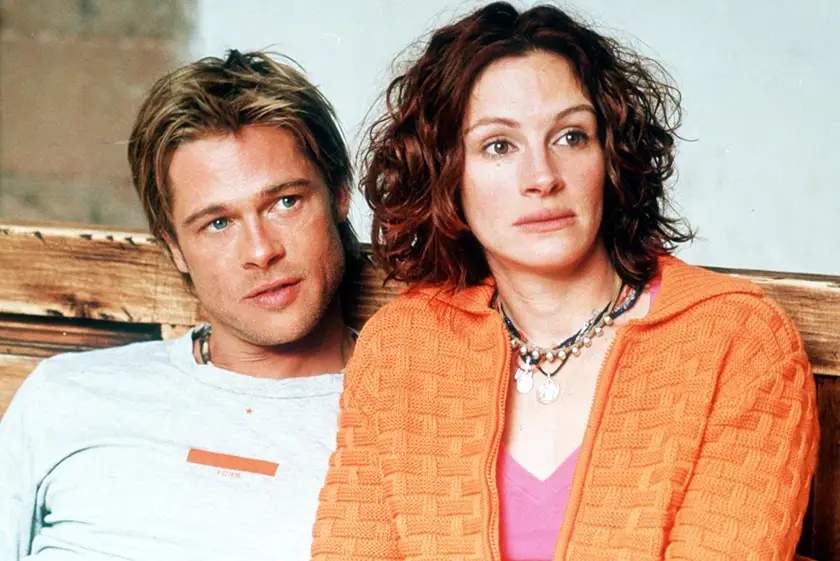
On paper, pairing two of Hollywood’s most charismatic stars seemed foolproof. You’ve got Brad Pitt and Julia Roberts, a quirky road trip, and a director fresh off the surprise success of Mouse Hunt. But instead of chemistry, the A-listers generate zero romantic spark as Pitt’s bumbling criminal chases a cursed pistol across Mexico while Roberts sulks in a side plot. James Gandolfini is the overall winner here, nearly stealing the film with what would become his trademark mix of warmth and menace. However, the script can’t decide if it’s a romance, a comedy, or a thriller, wasting the considerable talents of its cast (including Gene Hackman). Although it was commercially successful, taking in $150 million worldwide, this forgettable star vehicle remains a career lowlight that proves mega-watt smiles and good looks alone can’t overcome fundamental storytelling failures.
28. The Counselor (2013)
Director: Ridley Scott
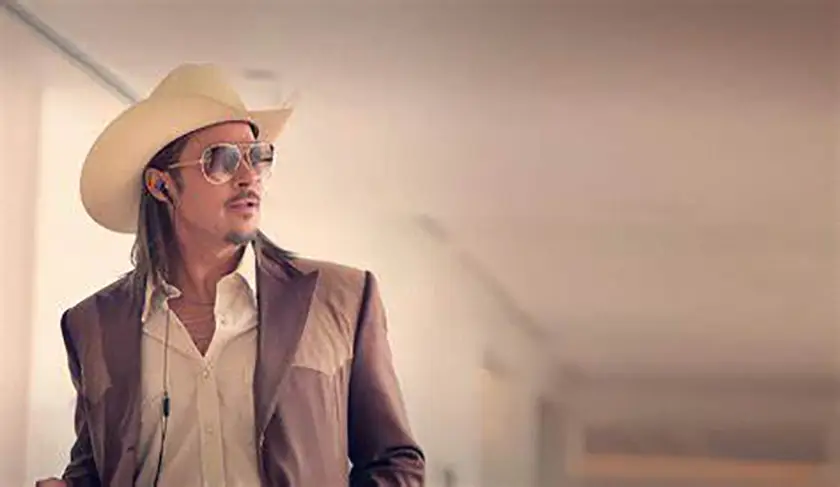
After the popularity of Cormac McCarthy’s No Country for Old Men in 2007, Hollywood was eager to accept an original script from the celebrated author known for his bleak, violent tales. McCarthy’s brutal screenplay for The Counselor reunited Brad Pitt with Thelma & Louise director Ridley Scott for a vile departure into Mexican drug trade horrors. Pitt plays a suave go-between in a drug deal that goes very wrong, and while he brings cool detachment, the film is soaked in grotesque cynicism, epitomizing the film’s low-class approach to high-concept material. Featuring what you might call a McCarthy signature, the frightening murder device, it one-ups the captive bolt pistol from No Country for Old Men by giving audiences “the bolito,” a self-constricting wire that decapitates victims.
Talky and nihilistic, Scott’s sleek direction aims for literary depth but, more often than not, lands in self-parody, especially in a scene as indescribably strange as Cameron Diaz’s notorious Ferrari scene, which amounts to pointless windshield erotica. While visually striking, it’s little more than a gratuitous display of Diaz acrobatically writhing against car glass for pure shock value rather than narrative purpose. This is prestige pulp at its worst, unable to overcome a feeling that it’s all beneath its talented ensemble cast, abandoning McCarthy’s usual philosophical depth for hollow exhibitionism that serves a narrow purpose.
27. Babylon (2022)
Director: Damien Chazelle
Damien Chazelle’s 189-minute Hollywood epic chronicles the silent-to-sound transition through the trajectories of screen stars on the polar opposite of their careers. A cocaine-snorting, elephant-stomping, jazz-drenched fever dream featuring Brad Pitt as a fading silent-era star with tragic swagger and an electric Margot Robbie wildly twirling amidst the chaos, Babylon assaults viewers with sexual excess and gruesome underground parties. It desperately desires to be a poetic statement on the birth of modern Hollywood but ends up feeling like a party you wish you’d been wise enough to exit two hours earlier.
Despite the expertly crafted production design, costumes, and score justifiably earning three Oscar nominations, this $80 million flop is deafening, exhausting, and strangely hollow. The opening twenty minutes alone test the lenience of its audience, while a beautiful finale montage spanning cinema history arrives too late to redeem the pulverizing experience. Eventually collapsing under its own self-serving weight, it’s a swing-for-the-fences movie that mostly whiffs, though Pitt gives it real weight, especially in a dynamite scene with Jean Smart.
26. By the Sea (2015)
Director: Angelina Jolie
The definition of a vanity project, By the Sea feels like watching a costly breakup in slow motion. Jolie directs herself and Pitt in this relationship drama as a couple unraveling in a seaside hotel with long silences, cigarettes, and sun-drenched sadness. Shot during Pitt and Jolie’s honeymoon and exuding major 1970s Euro-drama vibes, the film resembles a lost print from decades past. Despite its beautiful cinematography, which primarily uses natural light, Jolie’s intense passion for the grief-centered material doesn’t translate relatably to audiences, leaving the experience to feel more like a magazine spread than a movie. Their real-life marital troubles, later revealed through an ugly divorce, make viewing particularly cringe-worthy. Earning only $3.3 million against a $10 million budget, this emotionally cold and narratively thin career misfire proves that one’s artistic vision often requires a broader appeal to succeed commercially.
25. Ocean’s Thirteen (2007)
Director: Steven Soderbergh

Soderbergh’s trilogy conclusion marks the end of Danny Ocean’s run, maintaining the series’ sleek style and intricate plotting. While it’s sharp, fun, and full of Vegas razzle-dazzle as the gang seeks revenge against Al Pacino’s ruthless casino owner, it feels more like a reunion than a real story. There’s nothing inherently wrong with that, but it throws off some of the balance of the stakes, especially when you take into account the absence of Julia Roberts and Catherine Zeta-Jones, both of whom wisely declined to return to their underwritten roles.
Roberts leaves a noticeable void but Clooney and Pitt still have an unforced chemistry that’s wonderful to watch. Pacino hams it up as only he can as the villain, and bringing in his former Sea of Love costar Ellen Barkin was a nice touch. Like the previous two, it’s solid rainy-day entertainment that doesn’t reinvent the roulette wheel but still spins it smoothly one final time before walking into the sunset, ending the series on a high note.
24. Meet Joe Black (1998)
Director: Martin Brest
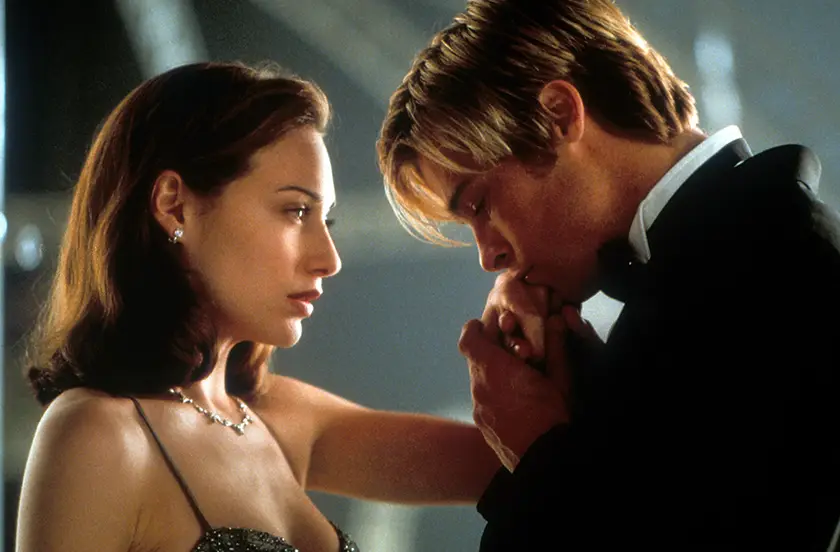
Three hours of Brad Pitt playing Death might sound absurd, but Meet Joe Black leans hard into its weird, solemn tone. Loosely based on Death Takes a Holiday, Martin Brest’s meditation on mortality features Pitt as Death experiencing humanity alongside Anthony Hopkins’ dying businessman whom he had come to collect. Instead, he decides to give Hopkins a few extra days and see how the other half lives, literally. Asking deep questions in a whispery monotone, Pitt handles the curious, otherworldly character well, transforming potential fish-out-water comedic moments into something more profound. However, the film takes itself far too seriously, and today, it’s mostly remembered for Pitt’s surreal attempt at Jamaican Patois and one of the wildest car accident scenes ever put to screen.
Playing the daughter of Hopkins, Claire Forlani works hard to focus her smoldering gaze throughout, though she finds little success, and it’s another example of Pitt rarely connecting with his co-star on a believably romantic level, which makes the run time feel all the more exasperating. Meet Joe Black is one of only six films directed by Brest. If someone were bold enough to remake it today, the source material is good enough for it to work as a limited series for a streamer. I don’t doubt that this episodic approach would be greeted with more success, avoiding accusations of testing the viewer’s patience, as Pitt’s version did. Lethargic storytelling aside, I always find this to be a strangely haunting film that lingers longer than I thought it would; its earnestness to understand life through death is both awkward and heartbreaking.
23. Seven Years in Tibet (1997)
Director: Jean-Jacques Annaud

“More like Seven Years in My Seat, right,” as my dad would have said. Pitt plays Austrian mountaineer Heinrich Harrer in this sweeping, gorgeously made, but slow-paced biopic about spiritual awakening at a time of significant global upheaval. Jean-Jacques Annaud’s drama follows Harrer’s imprisonment and eventual escape into Tibet, where he became a tutor to the young Dalai Lama. Shot in stunning locations and scored by John Williams featuring Yo-Yo Ma’s cello performance, the film hasn’t inspired repeat viewings despite its epic scope. It looks and sounds like a classic, but it’s more of a postcard than a page-turner. Additionally, Pitt’s accent is shaky (note that Pitt rarely is called on to do one), and today, the movie has aged into something slightly noble but mostly inert and emotionally distant.
The political controversy that surrounded the production and release of this biopic gave it a notoriety that outlasted its time in theaters. The Chinese government’s condemnation of the portrayal of the Dalai Lama led them to ban Pitt and the filmmakers from entering China for the following nineteen years. The next time Pitt would be allowed into China was to promote #22 on this list.
22. Allied (2016)
Director: Robert Zemeckis
Like many people I’ve talked to in the nine years since this was released, you’d be forgiven for forgetting this one even exists. Allied was dumped into theaters so inauspiciously that it barely registered, despite being led by Pitt and Oscar-winner Marion Cotillard in a WWII spy thriller from Robert Zemeckis. Pitt’s Canadian intelligence officer pairs well with Cotillard’s French Resistance fighter in 1942 Casablanca. While it aims for a sweeping mix of action, suspense, and romance to tell its tale of assassins falling in love during a mission, it can never quite figure out which part to emphasize.
It plays a bit like a Moroccan Mr. & Mrs. Smith, just without the undeniable chemistry between the leads and breakneck pacing. Zemeckis has assembled his usual high-class design team and wasn’t yet lost in his motion-capture filmmaking dreams, but the tension fizzles between action sequences, and the emotional beats intended to keep us hooked never land. Still, Cotillard looks incredible in Joanna Johnston’s elegant liquid silk dress featured on the poster (Johnston earned the sole Oscar nom for her costumes). If the film only excites in sporadic bursts, it’s thanks to the game performances from Pitt and Cotillard. Despite its polished craftsmanship and its delivery of the occasional thrill, Allied is mostly just… fine.
21. F1: The Movie (2025)
Director: Joseph Kosinski
Joseph Kosinski elevates familiar racing territory into an exhilarating entertainment vehicle that demonstrates Brad Pitt’s enduring screen charisma. Pitt embodies Sonny Hayes, a former Formula One racer scarred by a devastating accident who reluctantly returns to guide rising star Joshua Pearce (Damson Idris) on a faltering racing squad. Though the storyline follows expected rhythms, Pitt delivers commanding star power—he’s maturing gracefully, naturally suave while maintaining authentic edge. His rapport with the supporting players, especially Idris and Kerry Condon’s razor-sharp team director, breathes life into conventional material.
Kosinski’s filmmaking is sleek and calculated, featuring groundbreaking IMAX visuals that place viewers mere feet from burning rubber and Hans Zimmer’s booming soundtrack that propels each racing sequence. The narrative examines redemption and guidance themes without losing sight of what viewers crave: speed and adrenaline. Although hampered by mid-film pacing issues and excessive length, F1: The Movie triumphs chiefly as a sensory experience. It demonstrates how proper casting, technical excellence, and authentic genre appreciation can reinvigorate tried-and-true storytelling approaches.
20. Troy (2004)
Director: Wolfgang Petersen
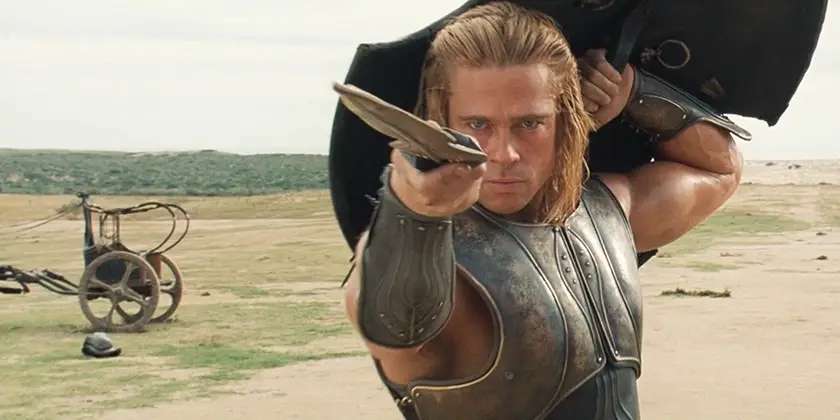
Slicing through Troy with his divine abs and mythic swagger, Pitt teams with director Wolfgang Petersen to turn Homer’s Iliad into a glossy sword-and-sandal epic spectacle. A showcase for Pitt at his golden god best, he is perfectly cast as Achilles, who leads the Greek assault on Troy. The film trims the epic down to blockbuster size, condenses the decade-long Trojan War into weeks, and loses some of its poetry in the process. It doubles down on brawn, though, prioritizing entertainment over faithfulness to the source material, resulting in a $497 million worldwide success.
While the special effects show their age, the physical production design remains impressive, featuring strong performances from Pitt and Eric Bana’s Hector, and their climactic duel is one for the ages. Before Christopher Nolan’s upcoming IMAX The Odyssey in 2026 becomes the definitive Homer interpretation, Troy remains the most palatable big-budget take on legendary homework material. It’s slightly lumbering and dimwitted but thoroughly entertaining.
19. Babel (2006)
Director: Alejandro González Iñárritu
Iñárritu’s multi-narrative drama is a heavy lift: a multi-strand global tragedy that weaves stories across Morocco, Japan, Mexico, and the United States, asking you to sit in the discomfort it has created. This $135 million success features Pitt plays an American tourist whose wife (Cate Blanchett) is accidentally shot in Morocco, triggering a cascade of events across continents. He’s heartbreakingly human here, stripped of vanity, playing a man unraveling in real-time. His character has already shared a terrible loss with Blanchett, and this new struggle is testing them further.
Supported by Gael García Bernal and Kōji Yakusho and earning two nominations for Best Supporting Actress for Adriana Barraza and Rinko Kikuchi, Iñárritu’s gentle touch with directing coaxes out stunning performances in everyone. While brilliantly crafted and ultimately earning seven Oscar nominations, including Best Picture, Babel exhausts viewers physically and emotionally. Its relentless suffering can feel almost punishing, making it a film easier to appreciate than love and not one you’ll be eager to revisit without setting aside recovery time afterward. Considerable artistic merit aside, Babel is hard to shake, showcasing Iñárritu’s talent for threading interlaced narratives and keeping them all in line.
18. Ocean’s Eleven (2001)
Director: Steven Soderbergh
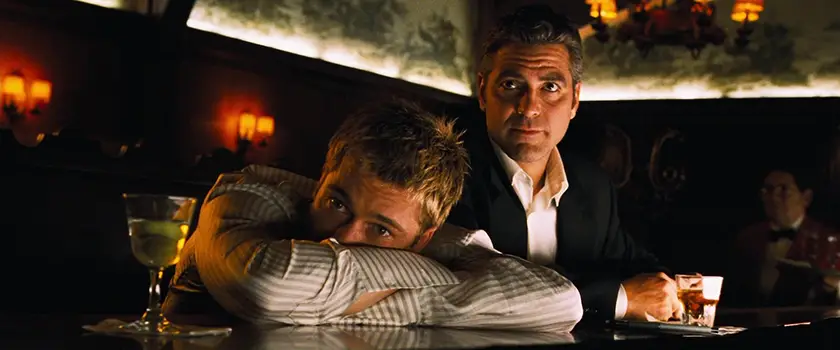
The perfect heist movie? Quite possibly. Blockbuster filmmaking done right? Absolutely. Soderbergh’s remake exemplifies how to improve upon mediocre source material, breathing new life into the Rat Pack’s musty 1960 Vegas mid-level caper romp. The complex scheme to simultaneously rob three major casinos was a terrific vehicle for George Clooney, who was reaching his peak alongside Pitt, laying the groundwork for the eventual evolution of his signature cool-breeze character, Rusty Ryan.
The ensemble cast of heavy hitters delights throughout in a ritzy Vegas setting, with everyone contributing to the effortless entertainment of a satisfying con. The Clooney/Pitt bromance is pure gold, but Julia Roberts was a genius bit of casting and one of Clooney’s best sparring partners. Rather than reverently updating a classic, Soderbergh recognized the creaky original’s limitations and created something genuinely superior and endlessly rewatchable, proving that remakes work best when they improve flawed concepts rather than perfecting masterpieces.
17. Ocean’s Twelve (2004)
Director: Steven Soderbergh
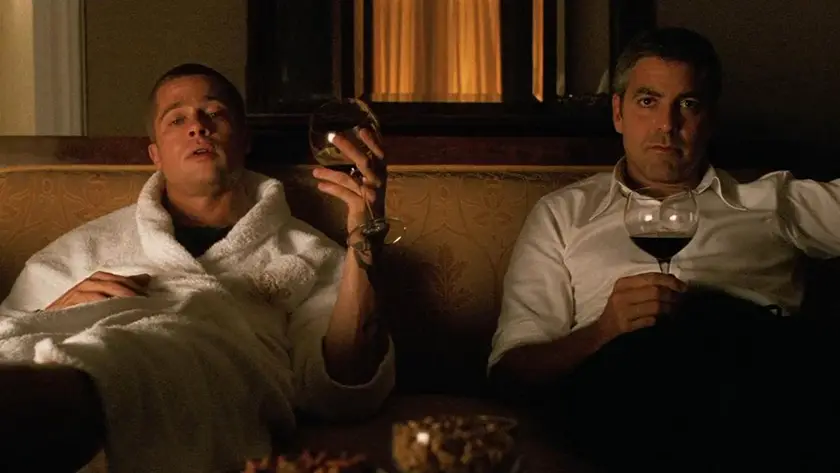
The series’ most divisive entry takes the biggest swing in any heist movie—and miraculously pulls it off. Looser, weirder, and way more playful, it’s the rare sequel that dares to get meta, including a moment where Julia Roberts plays a character pretending to be Julia Roberts. Pitt’s style for Rusty Ryan solidifies here as he glides through European locations on pure star power in impeccable suits. His dry, almost bored delivery hits differently here, proving genuine personality remains Hollywood’s rarest commodity. While Catherine Zeta-Jones adds female balance, Roberts steals everything with the fabulous meta-craftsmanship that shouldn’t work but does, leaving the movie funnier, riskier, and smarter than it gets credit for.
Watching all three together, the viewer can see that this clever snare wasn’t afraid to break the rules, creating the most interesting entry in a consistently entertaining franchise. This is where the franchise evolved beyond slick set-ups for state-of-the-art swindles; it became cool, postmodern art with complex narrative choices that reward multiple viewings.
16. Mr. & Mrs. Smith (2005)
Director: Doug Liman
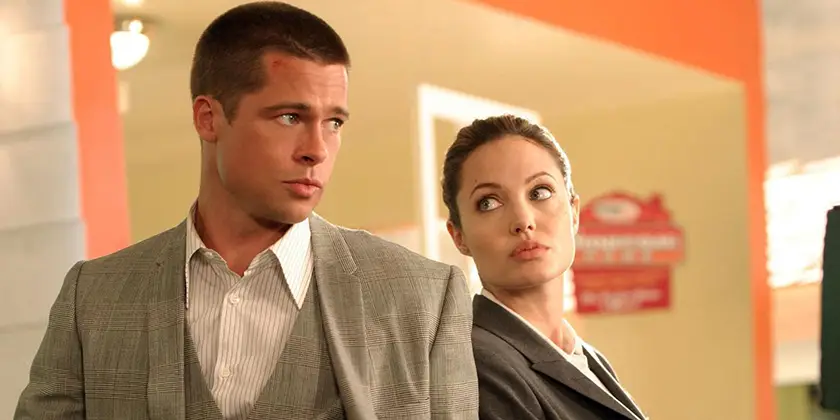
You can’t talk about Mr. & Mrs. Smith without bringing up the off-screen chemistry that changed tabloids forever. Doug Liman’s silky smooth action-comedy paired Hollywood’s hottest stars as spouses, unaware they are competing assassins that have been assigned to eliminate each other. The red-hot charisma between Pitt and Angelina Jolie ignites the screen, creating undeniable entertainment value beyond the off-screen romance that captivated audiences. Twenty years after its release and after a series remake on Prime, the OG still holds up on its own as a slick, sexy action-comedy.
While containing familiar building block elements from other secret-identity spouse films, the execution from Liman feels wholly original thanks to the leads’ electric chemistry, which could be classified as volcanic. The plot may have been thin, but nobody cared much because Liman brings the same kinetic energy he gave The Bourne Identity. This $487 million worldwide success stands as an odd reminder of that tabloid era for both stars but remains entertaining enough to transcend its real-life intrigue.
15. The Curious Case of Benjamin Button (2008)
Director: David Fincher
The short story by F. Scott Fitzgerald that inspired this movie already reads like an epic fable coated in melancholy, but in the hands of director David Fincher, it grows into something more special and unforgettable. Fincher’s somber but ambitious fantasy drama showcases his visual mastery through Pitt’s reverse-aging journey, supported by Oscar-winning effects and makeup. While the nearly three-hour runtime tests patience at times (this was when Fincher went through a stretch of holding on to too much of his movies), the film’s graceful reflection on time and mortality creates genuinely moving moments.
Pitt’s Oscar-nominated performance as Benjamin Button is wonderfully conceived, equal parts performance and visual effects wizardry. His reunion with Cate Blanchett finds them beautifully in sync, even if their chemistry burned stronger in Babel. Taraji P. Henson is one of the better Supporting Actress nominations in recent years as Benjamin’s adoptive mother. The film’s emotional arc is built around time slipping away, not just for Benjamin but for everyone he encounters. While the story might stretch credulity, this third Fincher-Pitt collaboration finds their creative partnership thriving, with Fincher at his most romantic and Pitt at his most subtly heartbreaking.
14. Legends of the Fall (1994)
Director: Edward Zwick
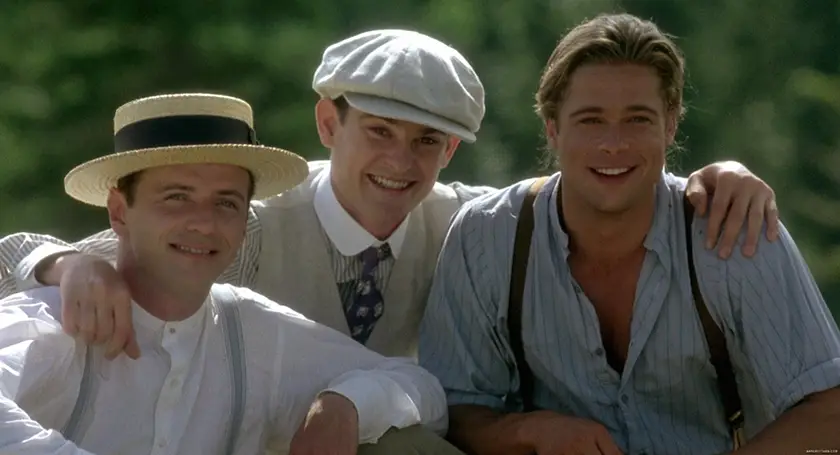
If you want to understand Brad Pitt’s 1990s superstardom, just watch him ride a horse with that lion’s mane in Legends of the Fall. This sweeping Montana epic epitomizes ’90s melodrama at its most unabashedly romantic. Pitt’s long locks practically deserve their own credit as he embodies the wild-hearted Tristan Ludlow across decades of family drama. Brothers in conflict, a war, a tragic love triangle; it’s all held together by Zwick’s lush direction, John Toll’s painterly cinematography (which won an Oscar), and Pitt’s brooding magnetism.
That’s not to say Anthony Hopkins, Julia Ormond, Aidan Quinn, and Henry Thomas don’t contribute their own strengths to old-fashioned storytelling, but Pitt finding his groove as a Renaissance movie star is impossible to ignore. Though it captures the untamed American West with breathtaking scope, the film’s plot borders on excessive, and the storytelling grows more overwrought as it sails past the two-hour mark. Its sense of scale and sentimentality makes for the kind of romantic epic Hollywood rarely produces anymore.
13. Interview with the Vampire (1994)
Director: Neil Jordan
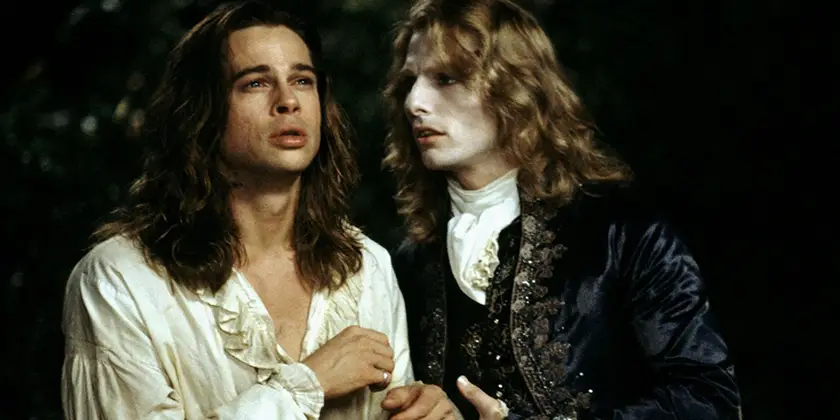
Jordan’s gothic, operatic, and strangely erotic masterpiece transforms Anne Rice’s brooding novel into sumptuous visual poetry, giving Pitt his first real chance to lean into tragedy. As the eternally tortured Louis, he ruminates for centuries while Tom Cruise’s flamboyant Lestat runs wild. Fans debated the casting, but Cruise is a total blast, and Pitt’s soulful restraint is a perfect foil. Watching the film from the lens of today, it’s hard to imagine why Cruise’s casting sparked such outrage; Rice herself endorsed the actor after seeing an early cut.
Pitt’s melancholic, deathly pale Louis provides the emotional anchor for several key characters in this tale of immortal torment. With lavish sets, dripping candle wax, and a young Kirsten Dunst stealing scenes as a child vampire, this is a horror movie with high style. The production overcame River Phoenix’s tragic death (Christian Slater replaced him), Pitt’s dissatisfaction during filming, and fan skepticism to create a movie that remains eloquently beautiful thirty years later. Pushing past traditional horror, it explores the burden of eternal damnation with aching sincerity.
12. Snatch (2000)
Director: Guy Ritchie
In a film packed with fast-talking criminals, stolen diamonds, and double-crosses, it’s Pitt’s mumbling, bare-knuckle boxer Mickey who walks off with Snatch. Guy Ritchie’s hyperactive style is all over the place, but it works, and Pitt’s choice to make Mickey nearly indecipherable is genius. Hot on the heels of Lock, Stock and Two Smoking Barrels, Ritchie brought back good luck charm Jason Statham, who leads the vibrant ensemble cast. Every supporting character gets an opportunity to steal the film, but it’s never a cutthroat competition—everyone’s on the same page, making the complex plot fly by with little time to breathe. Pitt’s willingness to cast aside his leading-man image and disappear into ensemble work demonstrates his fearless approach to character, proving that Hollywood glamour can transform into authentic British grit.
11. World War Z (2013)
Director: Marc Forster
Despite production nightmares and extensive reshoots, Forster’s high-concept zombie thriller revitalized a dying genre, and World War Z turned out to be one of the most gripping zombie films ever made. Pitt, who also shepherded the adaptation through his Plan B Entertainment, stars as former U.N. investigator Gerry Lane trying to stop a global outbreak, bringing real-world calm to the chaos. With an everyman relatability balanced against action-hero credibility, the film transforms potentially brain-dead material into genuinely thrilling entertainment, opting for globe-hopping tension over gore. It’s a shame the proposed sequel never got made because Pitt’s stoic determination helped give the film a clever, suspenseful, and surprisingly emotional edge.
10. Thelma & Louise (1991)
Director: Ridley Scott

Scott’s landmark feminist road movie launched Pitt into stardom with just fifteen minutes of unforgettably magnetic screen time. With a righteous mix of female empowerment, crime drama, and American mythmaking, the film became a cultural touchstone and a hot-button watercooler topic. What starts as a weekend getaway turns into a fugitive odyssey as two women reclaim agency in a world unfairly rigged against them. Susan Sarandon and Geena Davis give powerhouse, Oscar-nominated performances, and Callie Khouri’s Oscar-winning script wields rage, humor, and heartbreak with razor-sharp precision.
As charming drifter J.D., Pitt exploded off the screen; his scenes with Davis are sexy, sly, and just dangerous enough. This was the moment Hollywood said, “That guy’s a star.” Originally cast with Billy Baldwin, Pitt’s last-minute addition created one of the greatest scene-stealing moments of the ’90s. The film’s final moment is brave and iconic, but so is everything leading up to it.
9. Kalifornia (1993)
Director: Dominic Sena

A nasty, underrated gem of a road thriller, Kalifornia taps into early-’90s anxiety about serial killers, American violence, and the ever-diminishing line between fascination and complicity. Sena’s directorial debut transforms a simple road trip into a sweaty nightmare through Pitt’s unhinged performance as psychopath Early Grayce. It plays like a character study disguised as a horror film, with a yuppie journalist couple (David Duchovny and Michelle Forbes) documenting murder sites and picking up the wrong rideshare. Pitt’s volatile killer and his fragile girlfriend, played to perfection by then-partner Juliette Lewis, act as trailer-trash mirrors of the front-seat couple. This blood-chiller bombed theatrically, but found a cult following on VHS. Pitt’s Charles Manson-like charisma is equally magnetic and monstrous, showing his ease in disappearing completely into roles that demand psychological darkness.
8. A River Runs Through It (1992)
Director: Robert Redford
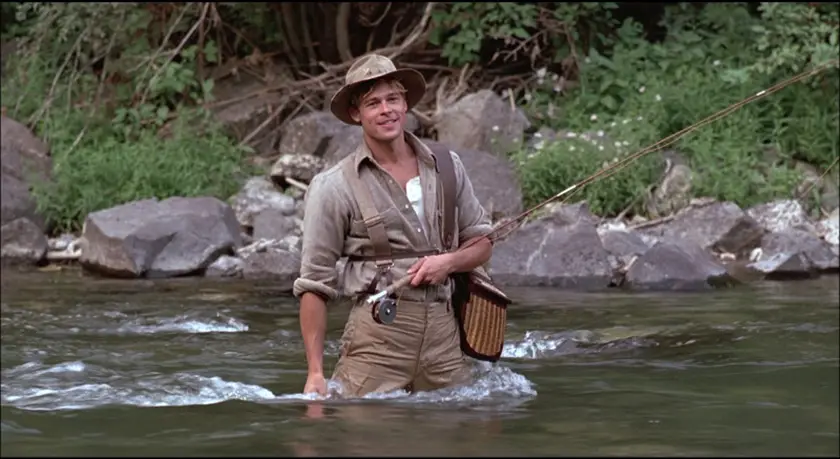
Redford’s lyrical coming-of-age masterpiece required Pitt to master fly-fishing in four weeks, training on L.A. rooftops before capturing his character’s poetic relationship with nature. As much about time, faith, and family as it is about fishing, this adaptation of Norman Maclean’s novella is drenched in nostalgic beauty and carried by a deep emotional undercurrent. As the wild brother, Pitt’s Paul Maclean embodies a rebellious spirit and athleticism, with the mesmerizing shadow-casting sequence becoming a legendary moment in cinema and earning John Toll an Oscar. While Pitt later expressed reservations about his performance, audiences recognized his star power in this quiet, powerful film. Its painterly beauty and contemplative pace make it one of the most serene and spiritually moving films of the ’90s.
7. Twelve Monkeys (1995)
Director: Terry Gilliam

Part sci-fi mystery, part psychological breakdown, Gilliam’s dystopian masterpiece earned Pitt his first Oscar nomination for playing manic mental patient Jeffrey Goines. Loosely based on the experimental short film La Jetée, it tells a looping, time-bending story of a future devastated by plague—and the desperate efforts to stop it. Gilliam’s trained eye for grimy, retro-futuristic detail makes every frame visually arresting. Initially doubting Pitt’s suitability for the role, Gilliam was convinced by the casting director’s instincts. Pitt spent weeks studying psychiatric wards and delivered a riveting performance that completed his massively successful 1994–95 stretch. It’s a story about destiny disguised as a thriller and has only improved with age, especially as our reality inches closer to its dystopian vision.
6. Fight Club (1999)
Director: David Fincher
A defining film of the ’90s that we still reference today, Fight Club is one of the rare pop culture lightning bolts that holds up under scrutiny. Fincher’s controversial cult classic is angry, stylish, and deeply cynical, and Pitt’s mysterious Tyler Durden is the perfect foil to Edward Norton’s unnamed narrator. This adaptation of Chuck Palahniuk’s novel contains a terrific twist that enhances repeat viewings. Ahead of its time in critiquing masculinity, consumerism, and identity, the film drags viewers through a descent into chaos and becomes more relevant with each passing year. Though a moderate failure at first, it found massive success on physical media. Pitt’s charismatic anarchist became the embodiment of Generation X’s rebellion, cementing Fight Club’s place in the canon.
5. Once Upon a Time… in Hollywood (2019)
Director: Quentin Tarantino
Tarantino’s revisionist memory piece is less a narrative and more a feeling: driving through 1969 L.A., watching old TV in smoky rooms, living through the end of an era. Part hangout movie, part slow-burn thriller, it’s a sun-soaked love letter to Hollywood that benefits immeasurably from Pitt’s relaxed charisma as stuntman Cliff Booth. His Oscar-winning performance pairs seamlessly with Leonardo DiCaprio’s fading Western star, putting both at their most natural. From shirtless rooftop scenes to the unforgettable Manson family finale, Pitt embodies nostalgic cool and achieves urban legend status. This is Tarantino at his most generous, and Cliff Booth one of cinema’s most endlessly watchable creations. (Fun note: David Fincher has signed on to direct a sequel with Pitt for Netflix.
4. The Assassination of Jesse James by the Coward Robert Ford (2007)
Director: Andrew Dominik

More tone poem than traditional Western, Dominik’s haunting masterpiece showcases Pitt’s most unsung performance as the paranoid outlaw Jesse James. The film explores legacy, obsession, and how an ordinary man becomes a legend. Roger Deakins’ Oscar-nominated cinematography creates an otherworldly beauty, perfectly matching Pitt’s nuanced portrayal, which won the Venice Film Festival’s Best Actor prize. Told through the anxious eyes of James’s eventual killer, it’s steeped in dread and unfolds at a languid, meditative pace. Released the same week as No Country for Old Men, it underperformed but has since been recognized as one of the best films of its decade.
3. Ad Astra (2019)
Director: James Gray
One of the boldest studio sci-fi films in years, Ad Astra is less about aliens and more about emotional detachment and father-son trauma. Pitt’s most restrained performance comes as astronaut Roy McBride, who journeys to the outer edges of the solar system to reconnect with his long-lost father. Gray’s introspective approach creates a quiet, cerebral odyssey that leans into emotional isolation. From a moon rover ambush to the lonely Neptune station, every set piece is meticulously designed. Pitt’s controlled delivery and subtle gestures convey a man defined by duty but drowning in generational grief. This performance deserved Oscar attention—it’s a space epic about coming home, not conquering.
2. Se7en (1995)
Director: David Fincher
Se7en is a noir-horror hybrid that’s lost none of its ability to disturb. From its rain-soaked city to its bone-chilling climax, Fincher crafts a serial-killer procedural that plays like a descent into hell. Pitt’s impulsive Detective Mills pairs with Morgan Freeman’s disillusioned veteran to track a murderer using the seven deadly sins. The atmosphere is suffocating, the crime scenes unforgettable, and the twist ending—still one of the most devastating in movie history. It’s the gut punch you know is coming yet still can’t shake. Se7en revitalized Fincher’s career and helped establish Pitt as a serious dramatic actor. It remains the gold standard in grim, intelligent thrillers.
1. Moneyball (2011)
Director: Bennett Miller
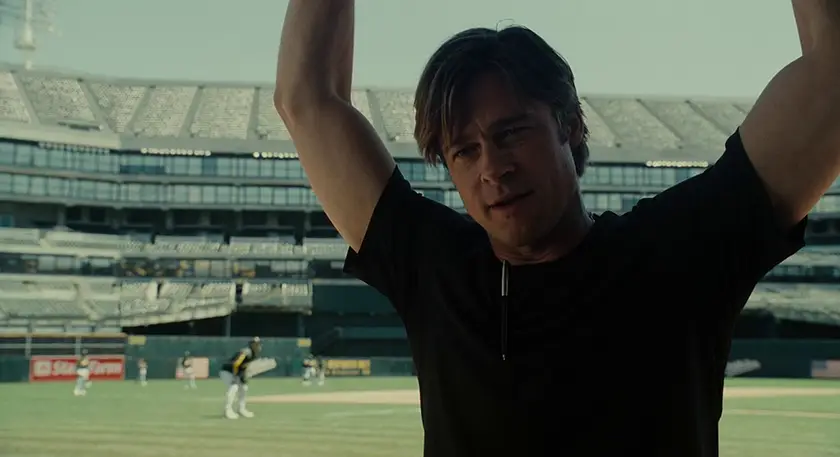
Baseball stats don’t sound like great cinema, but Moneyball proves otherwise. Miller’s stirring sports drama, adapted from Michael Lewis’s bestseller, is a grand slam of performance, writing, and direction. Pitt’s best performance comes as Oakland A’s GM Billy Beane, who revolutionizes the game using sabermetrics. But it’s not just about numbers; it’s about belief, disruption, and the refusal to accept defeat. The script by Aaron Sorkin and Steven Zaillian crackles with wit, and Pitt’s performance captures Beane’s vision and weariness with beautiful authenticity. His chemistry with Jonah Hill adds unexpected heart. It’s one of the great sports movies because it’s not about winning—it’s about changing the game.
F1: The Movie was released globally in theaters on June 25, 2025 and will be available to stream on Apple TV+ soon.

